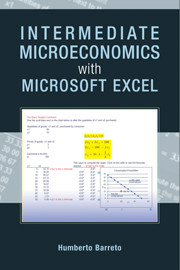3.1 - Partial Equilibrium
from PART III - THE MARKET SYSTEM
Published online by Cambridge University Press: 05 June 2012
Summary
Credit for the ubiquitous demand and supply diagrams in principles texts is usually given to Fleeming Jenkin [1870].…For the first time, a real visual sense of the market is located. Pride of place goes to the equilibrium price.
Judy KleinWe begin our analysis of the market system by making an obvious, but necessary point: A market demand (or supply) curve is the sum of individual demand (or supply) curves.
Step Open the Excel workbook SupplyDemand.xls and read the Intro sheet, then go to the SummingD sheet.
The sheet has three consumers, with three different utility functions and different incomes. We assume the consumers face the same prices for goods 1 and 2. We set p2 = 10, but leave p1 as an unknown in order to derive the individual demand curve for each consumer.
Step Confirm, by clicking on a few cells in the range B18:D22, that the formulas in these cells represent the individual demand curves for each consumer. Notice that the graphs below the data represent the individual demand (x1* = f(p1)) and inverse demand (p1 = f(x1*)) curves.
Given individual demands, market demand can be found by simply summing the optimal quantity demanded at each price.
Step Confirm, by examining the formula in cell E18, that market demand has been computed by adding the individual demands at p1 = 1. The same, of course, holds true for the other points on the market demand curve.
Information
- Type
- Chapter
- Information
- Intermediate Microeconomics with Microsoft Excel , pp. 425 - 522Publisher: Cambridge University PressPrint publication year: 2009
